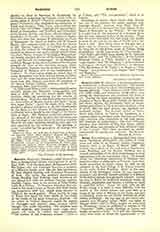

Baron, BONAVENTURA, a distinguished Irish Franciscan theologian, philosopher, and writer of Latin prose and verse, b. at Clonmel, County Tipperary, Ireland, 1610; d. at Rome, March 18, 1696. His mother was a sister of the well-known Franciscan, Luke Wadding, and his brother Geoffrey was a trusted ambassador of the Irish Confederates in their negotiations with the continental rulers. He himself joined the Franciscan community of Clonmel, pursued his studies in philosophy at Louvain, and afterwards proceeded to Rome, where he took up his residence in the Irish College of St. Isidore founded by his uncle, Father Wadding. Here, on the completion of his theological course, he was appointed professor, and devoted himself specially to a defense of the Scotist system then generally assailed. During his stay in Rome he published numerous works on theology, philosophy, and history, a full list of which is appended below. About the year 1651 he left Rome, owing, it is said, to some difficulty with the master of the sacred palace, and went first to a house of his order at Schwaz in the Tyrol, and then to Salzburg, where he was kindly received by Archbishop Guidobald. He was sent as provincial commissary into Hungary (about 1656), was again in Schwaz (1661), went to Paris, taught for some time at Wurzburg, where he published a volume of his “Opuscula” (1668), taught theology at Lyons, and finally returned to Italy. It is said that representations were made to secure his appointment to the Archbishopric of Cashel, but that he declined the office. He was appointed historiographer (1676) by Cosmo de’ Medici, Grand-duke of Tuscany, and was elected a member of the Academy of Florence. While under the patronage of the grand-duke he published the “Trias Tuscia”, in honor of three remarkable religious of the country, and, in the same year, the “Orbes Medicei”. His last work was a history of the Order for Redemption of Captives, from 1198 till 1297. He died March 18, 1696, and was buried at St. Isidore’s in Rome, where his tomb with the inscription, written by John De Burgo, a rector of the college, still exists. Two contemporary oil paintings of him have come down to us, one preserved in St. Isidore’s, the other in the Franciscan house, Dublin. His principal works are: “Panegyrici Sacroprophani” (Rome, 1643; Lyons, 1656); “Obsidio et expugnatio Arcis Duncannon sub Thoma Preston”; “Pi selusiones Philosophic” (Rome, 1651; Lyons, 1661); “Boetius Absolutus” (Rome, 1653); “Scotus defensus et amplificatus” (3 vols., Cologne, 1664); “Cursus Theologicus” (6 vols., 1670); “Opuscula” (4 vols., 1666-71); “Annales Ordinis Sanctw Trinitatis pro redemptione captivorum ab anno 1198 usque ad annum 1297” (Rome, 1864).
JAMES MACCAFFREY

